
(a)
Interpretation: The product of the given reaction is to be drawn including stereochemistry if appropriate.
Concept introduction: Alkyl tosylates undergo elimination reaction when they are allowed to react with strong nucleophilic base. The mechanism of the elimination reaction is
Answer to Problem 9.69P
The product of the given reaction is,

Figure 2
Explanation of Solution
The given reaction involves treatment of alkyl tosylate with
Alkyl tosylates undergo elimination reaction when they are allowed to react with strong nucleophilic base. The mechanism of the reaction is
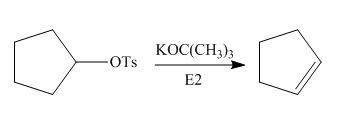
Figure 1
Thus, the product of the given reaction is,

Figure 2
The product of the given reaction is drawn in Figure 2.
(b)
Interpretation: The product of the given reaction is to be drawn including stereochemistry if appropriate.
Concept introduction: The reaction of alcohols with halogen acids
Answer to Problem 9.69P
The product of the given reaction is,

Figure 4
Explanation of Solution
The given reaction involves treatment of an alcohol with
The reaction of alcohols with halogen acids
The corresponding reaction is shown below.

Figure 3
Thus, the product of the given reaction is,

Figure 4
The product of the given reaction is drawn in Figure 4.
(c)
Interpretation: The product of the given reaction is to be drawn including stereochemistry if appropriate.
Concept introduction: Thiols react with
Answer to Problem 9.69P
The product of the given reaction is,
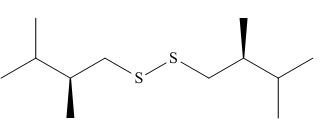
Figure 6
Explanation of Solution
The given reaction involves treatment of thiol with
Thiols react with
The corresponding reaction is shown below.

Figure 5
Thus, the product of the given reaction is,

Figure 6
The product of the given reaction is drawn in Figure 6.
(d)
Interpretation: The product of the given reaction is to be drawn including stereochemistry if appropriate.
Concept introduction: The
Answer to Problem 9.69P
The product of the given reaction is,
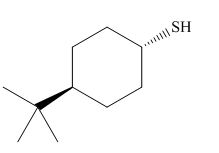
Figure 8
Explanation of Solution
The given reaction involves treatment of alkyl tosylate with
The

Figure 7
Thus, the product of the given reaction is,

Figure 8
The product of the given reaction is drawn in Figure 8.
(e)
Interpretation: The product of the given reaction is to be drawn including stereochemistry if appropriate.
Concept introduction: Alkyl bromides are obtained by the reaction of
Answer to Problem 9.69P
The product of the given reaction is,
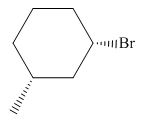
Figure 10
Explanation of Solution
The given reaction involves treatment of secondary alcohol with
Alkyl bromides are obtained by the reaction of

Figure 9
Thus, the product of the given reaction is,

Figure 10
The product of the given reaction is drawn in Figure 10.
(f)
Interpretation: The product of the given reaction is to be drawn including stereochemistry if appropriate.
Concept introduction: Alcohols are converted into alkyl tosylates by treatment with
Answer to Problem 9.69P
The product of the given reaction is,
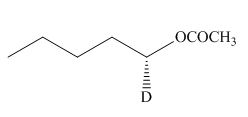
Figure 12
Explanation of Solution
The given reaction involves treatment of an alcohol with
Alcohols are converted into alkyl tosylates by treatment with
 Figure 11
Figure 11
Thus, the product of the given reaction is,

Figure 12
The product of the given reaction is drawn in Figure 12.
(g)
Interpretation: The product of the given reaction is to be drawn including stereochemistry if appropriate.
Concept introduction: The opening of an
Answer to Problem 9.69P
The product of the given reaction is,
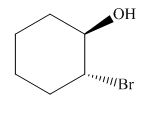
Figure 14
Explanation of Solution
The give reaction involves treatment of an epoxide with halogen acid
The opening of an epoxide/ethylene oxide ring is regioselective either it takes place with a strong nucleophile
The corresponding reaction is shown below.

Figure 13
Thus, the product of the given reaction is,

Figure 14
The product of the given reaction is drawn in Figure 14.
(h)
Interpretation: The product of the given reaction is to be drawn including stereochemistry if appropriate.
Concept introduction: The opening of an epoxide/ethylene oxide ring is regioselective either it takes place with a strong nucleophile
Answer to Problem 9.69P
The product of the given reaction is,
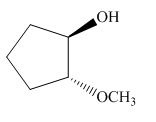
Figure 16
Explanation of Solution
The give reaction involves treatment of an epoxide with
The opening of an epoxide/ethylene oxide ring is regioselective either it takes place with a strong nucleophile
The corresponding reaction is shown below.

Figure 15
Thus, the product of the given reaction is,

Figure 16
The product of the given reaction is drawn in Figure 16.
(i)
Interpretation: The product of the given reaction is to be drawn including stereochemistry if appropriate.
Concept introduction: Ethers are the most common organic products of nucleophilic substitution reaction. They are prepared from alkyl halides and strong nucleophiles. The reaction proceeds through
Answer to Problem 9.69P
The product of the given reaction is,
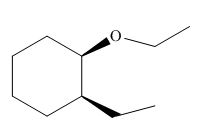
Figure 18
Explanation of Solution
The given reaction involves treatment of a
The alkoxide salts are prepared from alcohols through the Bronsted-Lowry acid-base reaction. In this reaction,
The obtained alkoxide from this reaction contains
The corresponding reaction is shown below.

Figure 17
Thus, the product of the given reaction is,

Figure 18
The product of the given reaction is drawn in Figure 18.
(j)
Interpretation: The product of the given reaction is to be drawn including stereochemistry if appropriate.
Concept introduction: Ethers react with strong acids, (only
In this reaction, both
Answer to Problem 9.69P
The product of the given reaction is,

Figure 20
Explanation of Solution
The given reaction involves treatment of an ether with two equivalents of
Ethers react with strong acids, (only
In this reaction, both
The corresponding reaction is shown below.

Figure 19
Thus, the product of the given reaction is,

Figure 20
The product of the given reaction is drawn in Figure 20.
(k)
Interpretation: The product of the given reaction is to be drawn including stereochemistry if appropriate.
Concept introduction: Sulfides are prepared from thiols by the successive treatment of sodium hydride (a good base), and an alkyl halide. The mechanism of the reaction is
Answer to Problem 9.69P
The product of the given reaction is,
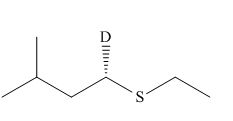
Figure 22
Explanation of Solution
The given reaction involves treatment of an alkyl halide with
The corresponding reaction is shown below.

Figure 21
Thus, the product of the given reaction is,

Figure 22
The product of the given reaction is drawn in Figure 22.
(l)
Interpretation: The product of the given reaction is to be drawn including stereochemistry if appropriate.
Concept introduction: Sulfide involves a nucleophilic sulfur atom. It reacts rapidly with unhindered alkyl halide to form corresponding sulfonium ion. The mechanism of the reaction is
Answer to Problem 9.69P
The product of the given reaction is,

Figure 24
Explanation of Solution
The given reaction involves treatment of sulfide with an unhindered alkyl halide.
Sulfide involves a nucleophilic sulfur atom. It reacts rapidly with unhindered alkyl halide to form corresponding sulfonium ion. The mechanism of the reaction is
The corresponding reaction is shown below.

Figure 23
Thus, the product of the given reaction is,

Figure 24
The product of the given reaction is drawn in Figure 24.
Want to see more full solutions like this?
Chapter 9 Solutions
Organic Chemistry
- 10. Write out the mechanism (intermediate/transition state) for this reaction; indicate stereochemistry in product. H3C CH₂OH CH3 SN1 Harrow_forwardWrite "most" under the member of each trio which is most stable. Write "least under the member of each trio which is least stable. b) Draw a Fischer projection of a pair of enantiomers with three chiral carbons. Which of these two would you expect to be more soluble in water? Why? 1-butanol 1-heptanol Which of these two would you expect to have the higher boiling point? Why? hexyl methyl ether 1-heptanolarrow_forwardWrite "most" under the most acidic compound. Write "least" under the least acidic compound. OH NO₂ OCH3 Br 9. Compound X, C50H84F2, reacts with excess H2/Pd to give a C50H88F2 compound. How many rings are in X? How many double bonds are in X? Show your work.arrow_forward
- 4. State whether these two are: a) the same molecule b) c) d) different compounds that are not isomers constitutional isomers diastereomers e) enantiomers CH3 CH₁₂ H OH HO H H OH HO H CH, CH₂ 5. a) How many stereocenters does this compound have? b) How many stereoisomers are possible for this compound? CH₂ OH CHCHarrow_forwardCalculating the pH at equivalence of a titration A chemist titrates 210.0 mL of a 0.1003 M hydrobromic acid (HBr) solution with 0.7550M KOH solution at 25 °C. Calculate the pH at equivalence. Round your answer to 2 decimal places. Note for advanced students: you may assume the total volume of the solution equals the initial volume plus the volume of KOH solution added. pH = ] ☑ o0o 18 Ararrow_forwardDo you do chemistry assignmentsarrow_forward
- Using the conditions of spontaneity to deduce the signs of AH and AS Use the observations about each chemical reaction in the table below to decide the sign (positive or negative) of the reaction enthalpy AH and reaction entropy AS. Note: if you have not been given enough information to decide a sign, select the "unknown" option. reaction observations conclusions A This reaction is always spontaneous, but proceeds slower at temperatures above 120. °C. ΔΗ is (pick one) AS is (pick one) ΔΗ is (pick one) B This reaction is spontaneous except above 117. °C. AS is (pick one) ΔΗ is (pick one) This reaction is slower below 20. °C than C above. AS is |(pick one) ? 18 Ar 1arrow_forwardCalculating the pH at equivalence of a titration Try Again Your answer is incorrect. 0/5 a A chemist titrates 70.0 mL of a 0.7089 M hydrocyanic acid (HCN) solution with 0.4574M KOH solution at 25 °C. Calculate the pH at equivalence. The pK of hydrocyanic acid is 9.21. Round your answer to 2 decimal places. Note for advanced students: you may assume the total volume of the solution equals the initial volume plus the volume of KOH solution added. pH = 11.43] G 00. 18 Ar B•arrow_forwardBiological Macromolecules Naming and drawing the products of aldose oxidation and reduction aw a Fischer projection of the molecule that would produce L-ribonic acid if it were subjected to mildly oxidizing reaction conditions. Click and drag to start drawing a structure. X AP ‡ 1/5 Naor Explanation Check McGraw Hill LLC. All Rights Reserved. Terms of Use Privacy Center Accessibilarrow_forward
- ● Biological Macromolecules Identifying the parts of a disaccharide Take a look at this molecule, and then answer the questions in the table below it. CH2OH O H H H OH OH OH H H CH2OH H O OH H OH H H H H OH Is this a reducing sugar? Does this molecule contain a glycosidic bond? If you said this molecule does contain a glycosidic bond, write the symbol describing it. If you said this molecule does contain a glycosidic bond, write the common names (including anomer and enantiomer labels) of the molecules that would be released if that bond were hydrolyzed. If there's more than one molecule, separate each name with a comma. Explanation Check O yes X O no ○ yes O no Uarrow_forwardThe aim of the lab is to measure the sodium content from tomato sauce using the Mohr titration method. There are two groups being: Regular Tomato sauce & Salt Reduced tomato sauce QUESTION: State how you would prepare both Regular & Salt reduced tomato sauce samples for chemical analysis using the Mohr titration methodarrow_forwardUsing the conditions of spontaneity to deduce the signs of AH and AS Use the observations about each chemical reaction in the table below to decide the sign (positive or negative) of the reaction enthalpy AH and reaction entropy AS. Note: if you have not been given enough information to decide a sign, select the "unknown" option. reaction observations conclusions A The reverse of this reaction is always spontaneous but proceeds faster at temperatures above -48. °C. ΔΗ is (pick one) ✓ AS is (pick one) B This reaction is spontaneous except below 114. °C but proceeds at a slower rate below 135. °C. ΔΗ is (pick one) AS is (pick one) ΔΗ is C This reaction is exothermic and proceeds faster at temperatures above -43. °C. (pick one) AS is (pick one) v Х 5 ? 18 Ararrow_forward
 ChemistryChemistryISBN:9781305957404Author:Steven S. Zumdahl, Susan A. Zumdahl, Donald J. DeCostePublisher:Cengage Learning
ChemistryChemistryISBN:9781305957404Author:Steven S. Zumdahl, Susan A. Zumdahl, Donald J. DeCostePublisher:Cengage Learning ChemistryChemistryISBN:9781259911156Author:Raymond Chang Dr., Jason Overby ProfessorPublisher:McGraw-Hill Education
ChemistryChemistryISBN:9781259911156Author:Raymond Chang Dr., Jason Overby ProfessorPublisher:McGraw-Hill Education Principles of Instrumental AnalysisChemistryISBN:9781305577213Author:Douglas A. Skoog, F. James Holler, Stanley R. CrouchPublisher:Cengage Learning
Principles of Instrumental AnalysisChemistryISBN:9781305577213Author:Douglas A. Skoog, F. James Holler, Stanley R. CrouchPublisher:Cengage Learning Organic ChemistryChemistryISBN:9780078021558Author:Janice Gorzynski Smith Dr.Publisher:McGraw-Hill Education
Organic ChemistryChemistryISBN:9780078021558Author:Janice Gorzynski Smith Dr.Publisher:McGraw-Hill Education Chemistry: Principles and ReactionsChemistryISBN:9781305079373Author:William L. Masterton, Cecile N. HurleyPublisher:Cengage Learning
Chemistry: Principles and ReactionsChemistryISBN:9781305079373Author:William L. Masterton, Cecile N. HurleyPublisher:Cengage Learning Elementary Principles of Chemical Processes, Bind...ChemistryISBN:9781118431221Author:Richard M. Felder, Ronald W. Rousseau, Lisa G. BullardPublisher:WILEY
Elementary Principles of Chemical Processes, Bind...ChemistryISBN:9781118431221Author:Richard M. Felder, Ronald W. Rousseau, Lisa G. BullardPublisher:WILEY





